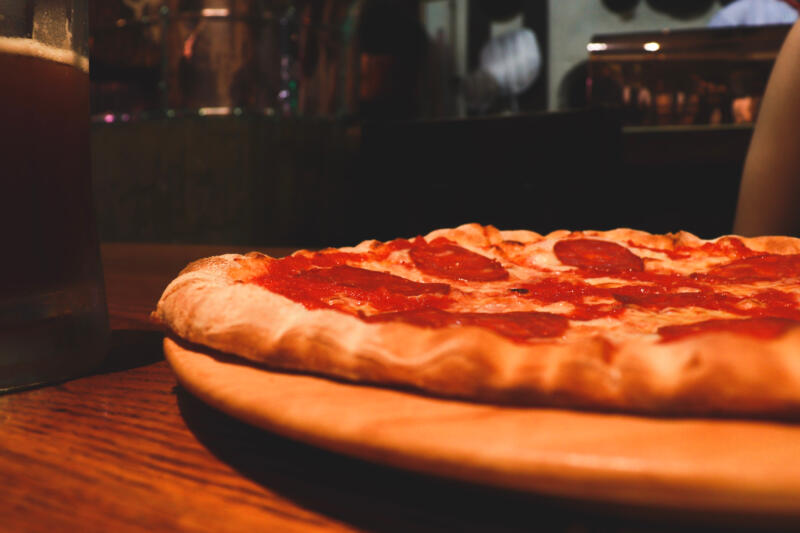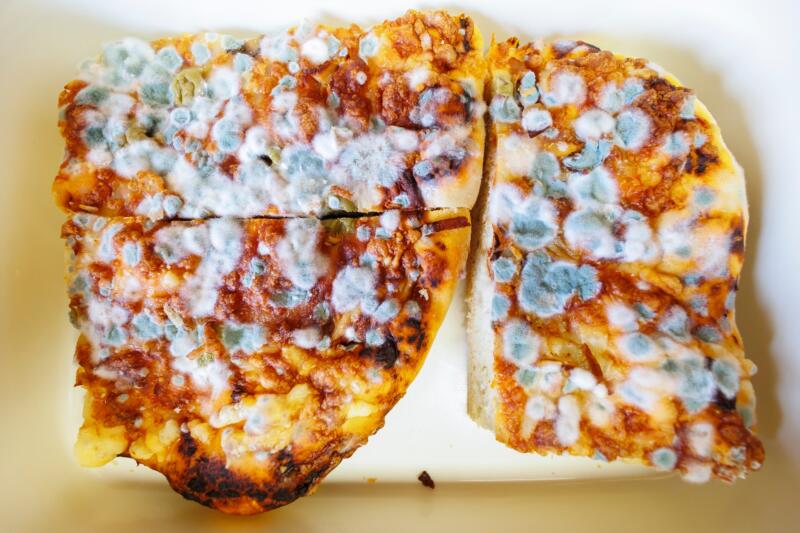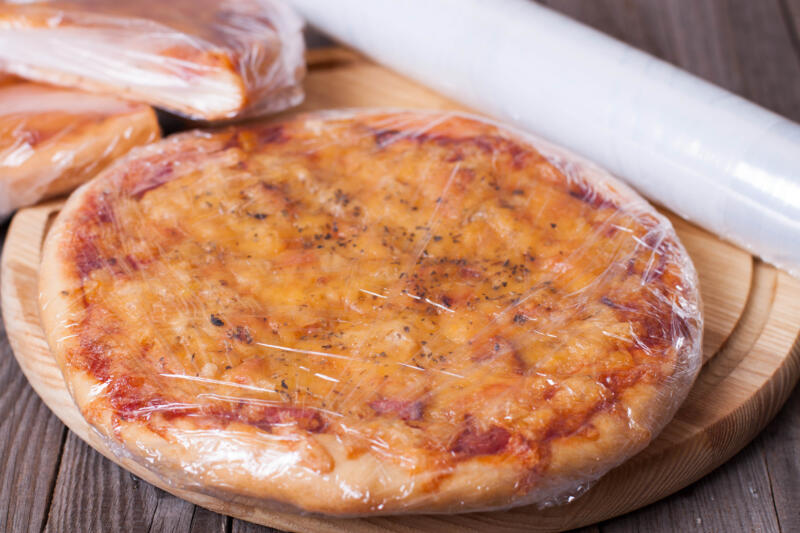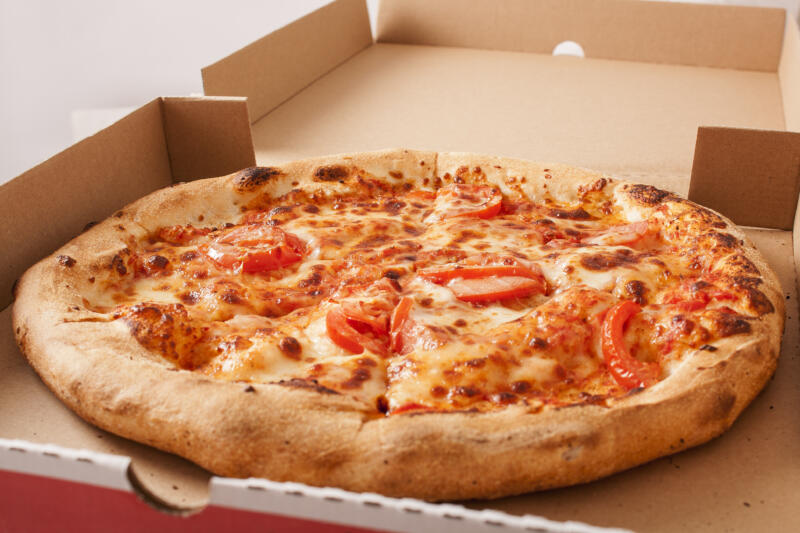We’ve all been there. You had a pizza party last night, and a few slices were left out on the counter. You wake up the next morning, and they’re still there, looking as delicious as ever.

But is it safe to eat that pizza left out overnight? The short answer is: it’s risky.
This article will guide you through the dangers of consuming pizza left out overnight, the signs of spoiled pizza, and how to properly store and reheat your leftover slices to ensure they remain safe to eat.
In this article:
The Risk of Eating Pizza Left Out Overnight
Consuming pizza that’s been left out overnight can expose you to bacterial growth, potentially causing food poisoning.
Pizza sitting at room temperature becomes a haven for such bacteria. These bacteria multiply rapidly, especially in the “danger zone” between 40°F and 140°F (4-60°C).
The longer the pizza sits out, the more bacteria grow, increasing the risk of food poisoning.
Risks of Food Poisoning

Food poisoning is a serious health risk associated with consuming food that has been improperly stored or prepared.
It can occur from eating contaminated pizza that has been left out overnight.
Let’s delve into the symptoms of food poisoning, the common bacteria that cause it, and the harmful effects of bacterial growth on pizza.
Symptoms of Food Poisoning

Food poisoning is no laughing matter. Consuming spoiled pizza can result in symptoms ranging from mild discomfort to severe dehydration and hospitalization.
The effects can be intense, manifesting as nausea, diarrhea, stomach cramps, fever, and shivering.
These symptoms can appear within hours or even days after consuming the contaminated pizza.
Common Bacteria That Cause Food Poisoning
The primary culprits behind pizza-related food poisoning are bacteria such as Bacillus cereus, Listeria, Salmonella, and Staphylococcus Aureus.
Each of these bacteria can lead to different symptoms and severity of illness.
Bacillus cereus, for example, is commonly found in foods and can cause diarrhea and vomiting.
Listeria, on the other hand, can lead to a more serious infection, especially in people with weakened immune systems, pregnant women, and newborns.
Salmonella and Staphylococcus aureus are other common culprits.
Salmonella can cause severe diarrhea, fever, and abdominal cramps, while Staphylococcus aureus produces toxins that can lead to nausea, vomiting, and stomach cramps.
Signs of Spoiled Pizza

Identifying spoiled pizza is crucial to avoid the unpleasant and potentially harmful effects of food poisoning. There are multiple indicators to determine if your pizza has spoiled.
Smell
One of the first things you should do when checking if your pizza has spoiled is to give it a good sniff.
The smell of spoiled pizza is often strange or foul, and it’s a clear sign that the pizza has gone bad and should not be consumed.
If your pizza has a sour, yeasty, or rancid smell, it’s best to err on the side of caution and discard it.
Appearance and Texture
The appearance and texture of pizza can also change when it has been left out overnight.
If your pizza has dried out, developed mold, or if the cheese has a dull color, it’s likely spoiled.
The texture can also be a giveaway. A soggy crust or slimy toppings are clear signs of spoilage.
Always remember, if in doubt, throw it out!
Taste
While it’s not recommended to taste pizza if you suspect it’s spoiled, sometimes the taste can be a clear indicator of spoilage.
An off or sour taste, unusual flavors, or an unpleasant aftertaste are all signs that the pizza has gone bad.
Pizza Varieties Most Prone to Spoilage
While all types of pizza can spoil if left out overnight, some are more susceptible than others.
Let’s take a closer look at the types of pizzas that are most at risk for spoilage: homemade pizzas, pre-made slices of pizza, and pepperoni pizzas.
1. Defrosted Pizzas
When it comes to defrosted pizza, proper handling is crucial to maintain its safety and quality.
If a frozen pizza is not defrosted under the right conditions, it could potentially harbor more bacteria.
For instance, defrosting pizza at room temperature can allow bacteria to multiply rapidly.
Even after baking, these bacteria can produce toxins that might not be destroyed by heat and could potentially lead to food poisoning if the pizza is left unrefrigerated for a long period.
Therefore, it’s recommended to defrost frozen pizza in the refrigerator to keep it at a safe temperature.
Once defrosted and baked, treat it like any other pizza – consume it immediately or store leftovers in the refrigerator within two hours to minimize the risk of bacterial growth.
2. Pre-Made Slices of Pizza
Pre-made slices of pizza, like those you might get from a pizza shop or commercial shop, can also pose a risk if not handled or stored properly.
While we’d like to believe that all food establishments adhere to strict hygiene standards, we can’t always be certain.
Factors such as whether the shop workers handled the pizza with clean hands or if it was stored at the correct temperature, all play a role in the pizza’s safety.
If these slices are left out at room temperature for more than two hours, they can become a breeding ground for bacteria, especially in a warm environment.
Therefore, it’s always best to consume pre-made pizza slices as soon as possible and avoid storing them for extended periods.
3. Homemade Pizzas
Homemade pizza may not contain preservatives that are often found in commercially prepared pizzas. Therefore, it might spoil faster if not properly stored.
4. Undercooked Pizzas
Undercooked pizza, especially those with meat toppings, can be a potential risk.
If the meat hasn’t reached a safe internal temperature during cooking, bacteria may not have been fully eliminated.
5. Pizza with Meat Toppings
Pepperoni pizzas, a favorite among many, come with their own set of risks when left out overnight.
The pepperoni, along with the cheese and sauce, can contribute to potential spoilage and bacterial growth when left at room temperature for an extended period of time.
Storing and Reheating Leftover Pizza Safely

The key to preserving your pizza is to limit its exposure to air and to keep it at safe temperatures.
Ideally, pizza should be refrigerated within two hours of being cooked.
If stored in the fridge, it’s best to consume it within 3-4 days, according to FoodSafety.gov.
For longer storage, you can freeze your pizza. Freezing halts bacterial growth altogether, allowing you to store your pizza for up to two months.
When storing, you can wrap your pizza slices in plastic food wrap or aluminum foil, or store them in airtight containers to prevent exposure to air and moisture.
Another effective way to preserve your pizza is to use a vacuum sealer. You can use it to remove air around the pizza, which can help to preserve it for longer periods.
When reheating, ensure the pizza reaches a temperature of at least 165°F (74°C) to kill any potential bacteria.

Myths and Misconceptions about Leftover Pizza
There are several myths and misconceptions about leftover pizza that can lead to unsafe food practices. Let’s debunk some of these:
Myth: Pizza Doesn’t Spoil

It’s a common misconception that because pizza undergoes a high-temperature baking process, it’s somehow immune to spoilage.
However, this couldn’t be further from the truth.
While the baking process does kill most bacteria present, once the pizza cools, it becomes susceptible to bacterial growth again, especially if not stored properly.
The ingredients used in pizza are perishable and can become a breeding ground for bacteria if left out for too long at higher temperatures.
Myth: Reheating Kills All Bacteria
While reheating pizza can kill some bacteria, it may not eliminate all, especially if the pizza has been left out for too long.
Reheating also does not get rid of toxins produced by some bacteria, which can still make you sick.
Myth: Pizza is Safe to Eat if it Doesn’t Smell Bad
The absence of a foul smell doesn’t necessarily mean the pizza is safe to eat.
Some bacteria don’t produce noticeable odors but can still cause food poisoning.
Myth: Pizza is Safe to Eat if There’s No Visible Mold
Not all spoilage is visible to the naked eye. While visible mold is a clear sign of spoilage, the absence of mold doesn’t guarantee that the pizza is safe to eat.
Bacteria can still be present and pose a risk.
Myth: Pizza Left in the Box is Safe to Eat
Pizza boxes are not designed for long-term storage. They don’t provide an airtight seal and can’t keep the pizza at safe temperatures, making the pizza susceptible to spoilage.
Remember, when it comes to food safety, it’s always better to err on the side of caution. If you’re unsure whether your pizza is safe to eat, it’s best to discard it.
Closing Thoughts
Understanding the risks associated with eating pizza left out overnight and knowing how to store and reheat leftovers safely is crucial for preventing food poisoning.
Always remember to refrigerate your pizza promptly, check for signs of spoilage, and reheat thoroughly before eating.
We hope you found this article informative and helpful.
If you have any questions or comments, feel free to share them.
Stay safe and enjoy your pizza responsibly!